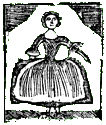Last Thursday Afternoon a young Woman from the Country was decoyed into one of the Barracks in Town, and most shamefully abused by some of the Soldiers there:—The same text appeared word for word later that day in the Boston Evening-Post, in the middle of the local news. Then it was repeated in various out-of-town newspapers, copied from one of the Boston articles.
the Person that enticed her thither, with promises of disposing of all her marketing there (who also belonged to the Country) was afterwards taken by the Populace and several times duck’d in the Water at one of the Docks in Town; but luckily for him he made his escape from them sooner than was intended;—
however, we hear, that after he had crossed the Ferry to Charlestown, on his return home, the People there being informed of the base Part he had been acting, took him and placed him in a Cart, and after tarring and feathering him (the present popular Punishment for modern delinquents) they carted him about that Town for two or three Hours, as a Spectacle of Contempt and a Warning to others from practising such vile Artifices for the Delusion and Ruin of the virtuous and innocent:
He was then dismissed, and permitted to proceed to the Town were he belonged, for them to act with him as they should think proper.
So far as I know, this is the only record of such an event taking place on 2 November. As a Thursday, that was indeed a market day when people from rural towns brought their goods into Boston to sell.
Unlike other tar-and-feathers attacks, such as the assault on sailor George Gailer on 28 October, there’s no mention of this mobbing in contemporary letters or diaries. None of the people involved appears to have filed a lawsuit (though it’s possible we still need to take a thorough look at Middlesex County records). I haven’t found a mention in other Boston newspapers published later that week.
This attack would be unusual in another way: All the other examples of tarring and feathering around this time involved punishing people who worked for or helped the Customs service, or broke the non-importation boycott which that agency opposed.
In contrast, this episode involved punishing a man for putting a young woman in sexual danger from soldiers. That was another way of violating community values, but on a much more local scale.
Does that suggest rural towns were inflicting similar tar-and-feather chastisements regularly? Or might Charlestown have used those materials only because the attacks on Cape Ann and in Boston a few days before had indeed made that “the present popular Punishment”?
Contrariwise, did the Boston Whig press make up this incident, or insert details like the out-of-town tar and feathers, in order to distract public attention from the well documented attack on Gailer? Lt. Gov. Thomas Hutchinson was issuing proclamations and promises of rewards for finding the culprits in that riot. The Whigs might have seen benefits in confusing newspaper readers with a similar incident, or spreading the idea that the victim the acting governor was talking about had actually harmed a young woman.

No comments:
Post a Comment